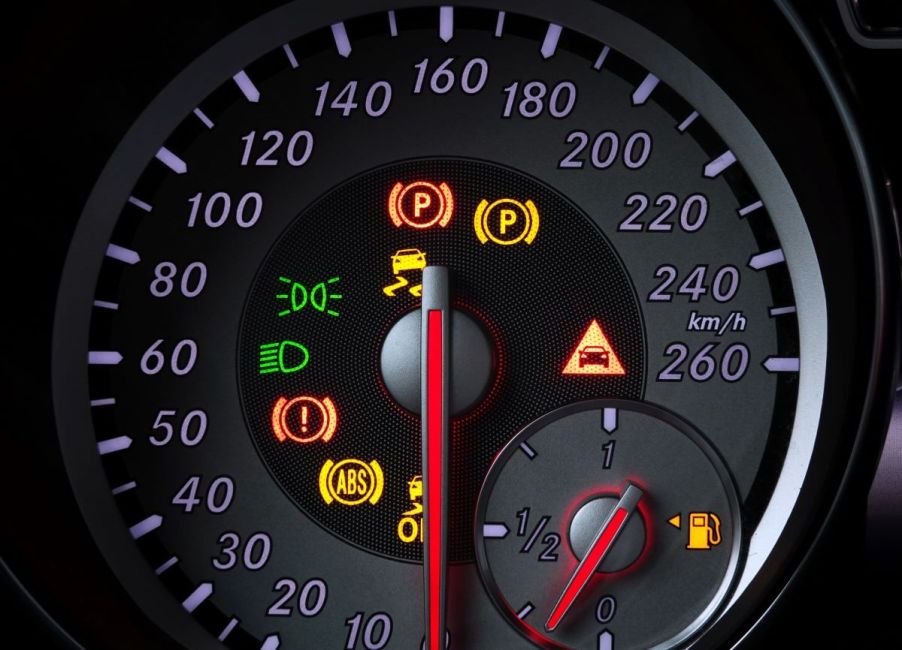
Why Are They Called Idiot Lights on a Car Dashboard?
Modern cars have an array of dashboard indicators. Warnings to check the engine, the tire pressure, the windshield washer fluid, and other areas light up like a Christmas tree. However, why are some called “idiot lights” or “dummy lights”? Is there a difference between gauges, lights, idiot lights, dummy lights, and car dashboard indicators?
Here’s everything you need to know about your car’s dashboard and why some indicators are considered idiot lights.
Why is it called an idiot light?

An idiot light is a warning light that appears on a car’s dashboard indicating a fault or failure that never happens or occurs after the vehicle has already broken down.
They’re called idiot lights because they’re frustratingly vague. They warn of trouble without explaining the issue. For example, a tire pressure light illuminates to tell you something is wrong with your tire pressure. A temperature light on your car’s dashboard might illuminate if something is amiss with the cooling system and your vehicle is running too hot. An oil light might flick on if your vehicle doesn’t have enough oil pressure, is low on oil, or needs an oil change.
Idiot lights or dummy lights directly contrast gauges, which offer more detailed information. In the luxury car era of the 1960s, gauges began to disappear from vehicles. It was a luxury just to have a speedometer and a fuel gauge. That trend continues, with most modern vehicles having only a few gauges. That leads to misunderstanding and confusion about your vehicle’s health. Instead of knowing exactly how hot your car is running, you have to trust an idiot light to tell you something is wrong. And even when this light illuminates, you don’t get any helpful information, just a vague warning that something is awry.
Additionally, some people call them “idiot lights” if the indicator is illuminated but nothing is wrong with the car beyond a faulty sensory triggering the light. It’s akin to the boy who cried wolf, Wiygul explains.
However, ignoring an idiot light could be a costly or dangerous mistake.
What do certain lights mean on a car dashboard?

Here are some of the most common lights on car dashboards and what they mean when illuminated:
- Check engine light: The icon for this light looks like an engine block. It could mean something catastrophic might occur in your car’s engine. Indicating anything from misfiring to active engine damage, the check engine light should be addressed as soon as possible.
- Oil pressure light: The oil pressure light is shaped like an old oil can. It illuminates if your engine is not building enough oil pressure due to a lack of oil in the system or a leak. This light should also be addressed immediately to avoid internal damage.
- Battery light: Shaped like a car battery, this warning comes on if your car is low on battery power. The light can also turn on if the alternator is failing. Don’t ignore this one, either, because a dead battery could leave you stranded.
- Temperature light: The temperature warning light appears if your engine reaches a temperature that could cause damage. This light looks like a thermometer in water. If you see this light come on or turn red, your vehicle is too hot and needs to be turned off immediately before catastrophic engine damage occurs.
- Tire pressure monitoring system (TPMS) light: The TPMS light, shaped like a horseshoe with an exclamation point in the middle, shows that at least one of your tires is lower than the recommended pressure.
What is the most serious warning light on a car dashboard?
The most serious warning light on a car dashboard is by far the check engine light. It means your engine is likely experiencing something that could cause serious damage. Check engine lights rarely illuminate for no reason, although it’s possible. Sometimes, they might flick on because of something as minor as a loose gas cap. That causes an issue with the emissions systems, triggering the light.
When it comes to idiot lights or dummy lights, the most important ones to watch are the check engine light, temperature light, battery light, and oil pressure light. Other maintenance lights, like windshield washer fluid and scheduled service alerts, aren’t as pressing and can be addressed at your earliest convenience.






